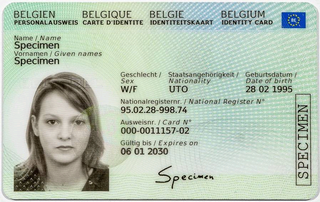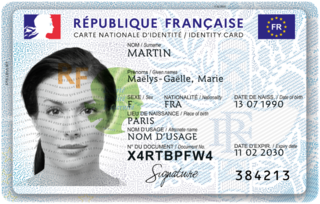An identity document is any document that may be used to prove a person's identity. If issued in a small, standard credit card size form, it is usually called an identity card, or passport card. Some countries issue formal identity documents, as national identification cards that may be compulsory or non-compulsory, while others may require identity verification using regional identification or informal documents. When the identity document incorporates a person's photograph, it may be called photo ID.

A Belgian identity card is a national identity card issued to all citizens of Belgium aged 12 years old and above.

The French national identity card is an official identity document consisting of an electronic ID-1 card bearing a photograph, name and address. While the identity card is non-compulsory, all persons must possess some form of valid government-issued identity documentation.

The Czech national identity card is the identity document used in the Czech Republic, in addition to the Czech passport. It is issued to all citizens, and every person above 15 years of age permanently living in the Czech Republic is required by law to hold a valid identity card.

Hungarian passports are issued to Hungarian citizens for international travel by The Central Data Processing, Registration and Election Office of the Hungarian Ministry of the Interior. Every Hungarian citizen is also a citizen of the European Union. The passport, besides the national identity card allows for free rights of movement and residence in any of the states of the European Union, European Economic Area and Switzerland.

The Armenian passport is a passport issued to Armenian citizens to enable them to travel outside Armenia, and entitles the bearer to the protection of Armenia's consular officials overseas. Armenian citizens have visa-free or visa on arrival access to 65 countries and territories as of 2023.

A Norwegian passport is the passport issued to nationals of Norway for the purpose of international travel. Beside serving as proof of Norwegian citizenship, they facilitate the process of securing assistance from Norwegian consular officials abroad.

The Swedish national identity card is a non-compulsory biometric identity document issued in Sweden. It is one of two official identity documents issued by the Swedish Police, the other being the Swedish passport. It is only issued to Swedish citizens, and indicates the citizenship.

Slovenian passports are issued to citizens of Slovenia to facilitate international travel. Every Slovenian citizen is also a citizen of the European Union. The passport, along with the national identity card allows for free rights of movement and residence in any of the states of the European Union, European Economic Area and Switzerland, as a result of the right of free movement and residence granted in Article 21 of the EU Treaty.

The Croatian identity card is an identity document issued in Croatia. Any Croatian citizen who is resident in Croatia can obtain an ID card and it is compulsory for all citizens over the age of 18. This document is issued by the police on behalf of the Ministry of the Interior.

Hungarian identity cards are not compulsory for Hungarian citizens, although they may be obtained by anyone after birth. However, every citizen from 14 years of age must have at least one of the three identity documents: national identity card; passport, under the age of 17 years; or a photo-card driving licence for anyone over 17 years old. Citizens can travel anywhere in Europe as well as to Georgia, French overseas territories, Montserrat, Turkey and organized tours to Tunisia using only this identity card.

The Slovak citizen ID card is the identity document used in the Slovak Republic, in addition to the Slovak passport. It is issued to all citizens, and every person above 15 years of age permanently living in Slovakia. It is required by law to hold a valid identity card.

The Bulgarian identity card is a compulsory identity document issued in Bulgaria. The document is issued by the police on behalf of the Ministry of Interior and is the main form of identification on the territory of the Republic of Bulgaria. All Bulgarians are obliged by law to carry their identity cards with them at all times and are subject to fines should they not.

The Swiss identity card in its current form dates back to July 1994. It is in the form of a plastic photocard. It can be used as a travel document when travelling within European Free Trade Association or to the European Union, the European microstates, Georgia, Turkey, and on organized tours to Tunisia.

The Portuguese identity card, is an identity document issued by the Government of Portugal to its citizens. The card replaces several previous documents, including the Bilhete de Identidade, Social Security card, National Health Service card, Taxpayer card and voter registration card, in one secure card. The Citizen Card was first issued in the Azores in mid-2006. However, as of 2017 BIs continued to be issued in some cases.

The Cypriot identity card is issued to citizens of Cyprus. It can be used as a travel document when visiting countries in Europe, as well as French overseas territories, Montserrat and Georgia. This document is not valid in Turkey.

The Greek identity card is the official national identification document for Greek citizens. It is issued by the Hellenic Police.

The national identity cards are identity documents issued to citizens of nations in the European Union (EU) and European Free Trade Association (EFTA) member states, with the exception of Denmark and Ireland. The identity cards have been harmonized as a new common identity card model replaced the various formats in use on 2 August 2021.

The Latvian identity card, also known as Personal certificate, is an officially recognised biometric identity document issued to Latvian citizens. They are also valid for travel within Europe, Georgia, French Overseas territories, Montserrat and organized tours to Tunisia.

The Norwegian identity card, commonly referred to as the national identity card in Norway, is a non-compulsory biometric identity document issued since 30 November 2020. It is one of two official identity documents issued by the Norwegian Police Service, the other being the Norwegian passport. It is only issued to Norwegian citizens, and may indicate citizenship so that it can be used as a travel document facilitating freedom of movement within the European Free Trade Association and the European Economic Area. For travel within the Nordic countries no identity documentation is legally required for Nordic citizens due to the Nordic Passport Union.




















